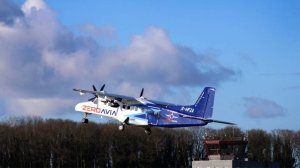Zero-emissions aviation company reports record-breaking fuel cell performance tests


ZeroAvia’s modified Dornier D 228 takes off on its first flight with a hybrid-electric powertrain, in January
Photo by ZeroAvia
UK-US zero-emission aviation technology company ZeroAvia has announced that early tests of its High Temperature Proton Exchange Membrane (HTPEM) fuel cell systems delivered performances that were record-breaking. The tests were conducted at the company’s UK research and development (R&D) site and involved its 20 kW HTPEM stack power module. This achieved a record specific power of 2.5 kW/kg at the cell level. This opened the way to the company reaching 3+ kW/kg system level densities within the next two years.
ZeroAvia sees fuel cells as the only practical option to achieve true zero-emissions aviation. Hydrogen combustion would eliminate carbon dioxide emissions but could still produce nitrous oxide emissions, and nitrous oxide was very definitely a greenhouse gas. However, ZeroAvia’s then record-breaking flight of a modified 19-seat Dornier Do 228 feederliner aircraft in January involved a low temperature proton exchange membrane (LTPEM) system. That aircraft had one of its conventional turbine engines replaced by a hybrid-electric powertrain that drew its energy from two LTPEM fuel stacks.
“ZeroAvia’s team has made unprecedented deep tech[nology] breakthroughs by delivering a pressurised HTPEM system, innovative conductive coatings enabling the use of aluminium bipolar plates in highly aggressive HTPEM environments, and a novel approach to advanced membrane electrode assembly,” reported the company. “ZeroAvia’s proprietary technology has been developed over the past three years as part of a concentrated effort to build an in-house portfolio of critical technologies for fuel cell aviation at ZeroAvia. Further R&D will deliver over 3 kW/kg fuel cell system specific power, making fuel cell propulsion commercially viable for large aircraft.”
Pressurised HTPEM technology is essential for use in energy intensive aviation applications, such as rotorcraft and large fixed-wing aircraft. Increasing the temperature and pressure in a fuel cell stack permits the use of air cooling, simplifies the system, reduces cooling drag and allows their use in significantly more demanding applications. The HTPEM systems now being developed by the company will be the prime candidates for the energy sources for its ZA2000 powertrain. The ZA2000 will power 40- to 80-seat commercial aircraft, as well as rotorcraft and electric vertical take-off or landing (or urban air mobility) aircraft. These fuel cells might also be able to power 100+-seat single-aisle turbofan-powered airliners.
“The companies and geographies that seize the lead in high fuel cell temperatures and pressures will lead the industry,” highlighted ZeroAvia CEO Val Miftakhov. “This progression is similar to the story of turbine engines, where ever-increasing temperatures and pressures drove higher and higher performance. Hydrogen fuel cell propulsion is the most environmental and economical alternative to existing engines, and HTPEM is the most promising route to delivering these benefits into large aircraft categories. I am confident that what we are demonstrating now is the core building block to delivering zero-emission flight for all categories of aircraft in the long term.”
Components used by the company in its system have been validated by third-party independent laboratory testing, including tests at a US Department of Energy lab. The development of the HTPEM system has been partly funded by the UK government, through the country’s Aerospace Technology Institute, under the HyFlyer II project.
Comments
Announcements
What's On
Subscribe to improve your user experience...
Option 1 (equivalent of R125 a month):
Receive a weekly copy of Creamer Media's Engineering News & Mining Weekly magazine
(print copy for those in South Africa and e-magazine for those outside of South Africa)
Receive daily email newsletters
Access to full search results
Access archive of magazine back copies
Access to Projects in Progress
Access to ONE Research Report of your choice in PDF format
Option 2 (equivalent of R375 a month):
All benefits from Option 1
PLUS
Access to Creamer Media's Research Channel Africa for ALL Research Reports, in PDF format, on various industrial and mining sectors
including Electricity; Water; Energy Transition; Hydrogen; Roads, Rail and Ports; Coal; Gold; Platinum; Battery Metals; etc.
Already a subscriber?
Forgotten your password?
Receive weekly copy of Creamer Media's Engineering News & Mining Weekly magazine (print copy for those in South Africa and e-magazine for those outside of South Africa)
➕
Recieve daily email newsletters
➕
Access to full search results
➕
Access archive of magazine back copies
➕
Access to Projects in Progress
➕
Access to ONE Research Report of your choice in PDF format
RESEARCH CHANNEL AFRICA
R4500 (equivalent of R375 a month)
SUBSCRIBEAll benefits from Option 1
➕
Access to Creamer Media's Research Channel Africa for ALL Research Reports on various industrial and mining sectors, in PDF format, including on:
Electricity
➕
Water
➕
Energy Transition
➕
Hydrogen
➕
Roads, Rail and Ports
➕
Coal
➕
Gold
➕
Platinum
➕
Battery Metals
➕
etc.
Receive all benefits from Option 1 or Option 2 delivered to numerous people at your company
➕
Multiple User names and Passwords for simultaneous log-ins
➕
Intranet integration access to all in your organisation



















